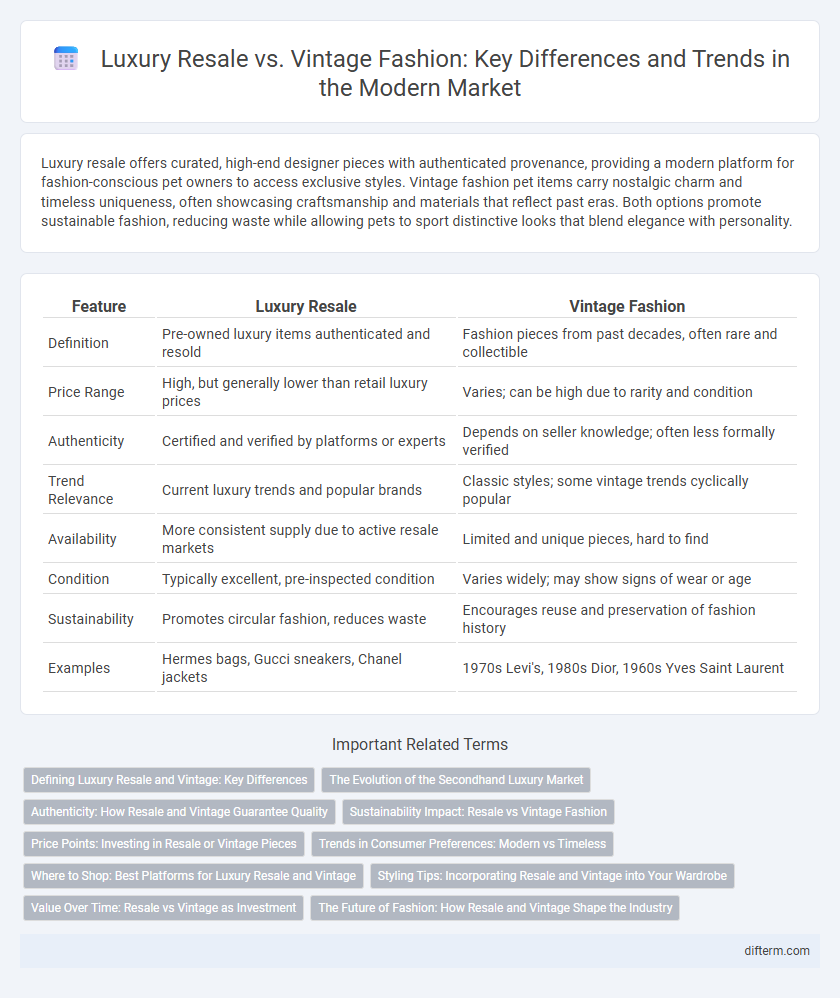Luxury resale offers curated, high-end designer pieces with authenticated provenance, providing a modern platform for fashion-conscious pet owners to access exclusive styles. Vintage fashion pet items carry nostalgic charm and timeless uniqueness, often showcasing craftsmanship and materials that reflect past eras. Both options promote sustainable fashion, reducing waste while allowing pets to sport distinctive looks that blend elegance with personality.
Table of Comparison
| Feature | Luxury Resale | Vintage Fashion |
|---|---|---|
| Definition | Pre-owned luxury items authenticated and resold | Fashion pieces from past decades, often rare and collectible |
| Price Range | High, but generally lower than retail luxury prices | Varies; can be high due to rarity and condition |
| Authenticity | Certified and verified by platforms or experts | Depends on seller knowledge; often less formally verified |
| Trend Relevance | Current luxury trends and popular brands | Classic styles; some vintage trends cyclically popular |
| Availability | More consistent supply due to active resale markets | Limited and unique pieces, hard to find |
| Condition | Typically excellent, pre-inspected condition | Varies widely; may show signs of wear or age |
| Sustainability | Promotes circular fashion, reduces waste | Encourages reuse and preservation of fashion history |
| Examples | Hermes bags, Gucci sneakers, Chanel jackets | 1970s Levi's, 1980s Dior, 1960s Yves Saint Laurent |
Defining Luxury Resale and Vintage: Key Differences
Luxury resale refers to the buying and selling of authenticated, pre-owned high-end designer items, often sourced from recent collections or gently used pieces with verified brand provenance. Vintage fashion specifically denotes clothing or accessories that are at least 20 to 30 years old, showcasing distinctive styles from past eras and often prized for rarity and historical value. The primary difference lies in the age and cultural significance of the items, with luxury resale emphasizing current market demand for near-new luxury goods, while vintage centers on unique, aged pieces with enduring style heritage.
The Evolution of the Secondhand Luxury Market
The secondhand luxury market has rapidly evolved, driven by increased consumer interest in sustainable fashion and the desire for unique, high-quality pieces. Luxury resale platforms now offer authenticated designer goods with transparency and convenience, shifting perceptions of pre-owned items from outdated to coveted. Vintage fashion remains prized for its timeless appeal and rarity, but resale services have democratized access, expanding market growth and redefining luxury consumption.
Authenticity: How Resale and Vintage Guarantee Quality
Luxury resale platforms authenticate each item through expert verification and advanced technology to ensure genuine quality and brand integrity. Vintage pieces undergo rigorous provenance checks and condition assessments, preserving their historical value while guaranteeing authenticity. Both resale and vintage markets prioritize transparency and trust, providing consumers with verified, high-quality fashion investments.
Sustainability Impact: Resale vs Vintage Fashion
Luxury resale reduces environmental impact by extending the lifecycle of contemporary designer pieces, minimizing waste and resource consumption associated with new production. Vintage fashion promotes sustainability by preserving unique, time-tested garments, often crafted with higher-quality materials and techniques, which reduces demand for fast fashion. Both luxury resale and vintage fashion contribute significantly to lowering carbon footprints and promoting circular fashion economies within the fashion industry.
Price Points: Investing in Resale or Vintage Pieces
Luxury resale items typically offer more accessible price points compared to vintage pieces, which often carry a premium due to rarity and provenance. Resale markets provide opportunities to acquire high-end brands at discounted rates, appealing to budget-conscious fashion enthusiasts. Vintage investments, while pricier, tend to appreciate in value over time, making them attractive for collectors seeking unique, timeless pieces.
Trends in Consumer Preferences: Modern vs Timeless
Consumer preferences in the fashion industry increasingly favor luxury resale for its blend of modern trends and sustainability, offering contemporary styles from recent high-end collections. Vintage fashion attracts those seeking timeless, unique pieces with historical significance and classic appeal that never go out of style. The shift highlights a dual demand: luxury resale satisfies fast-evolving tastes, while vintage caters to the desire for enduring elegance and originality.
Where to Shop: Best Platforms for Luxury Resale and Vintage
The top platforms for luxury resale include The RealReal, Vestiaire Collective, and Fashionphile, known for authenticating high-end designers like Chanel, Hermes, and Louis Vuitton. For vintage shopping, Etsy, Depop, and eBay offer diverse collections ranging from classic mid-century fashion to rare designer pieces, appealing to collectors and trendsetters alike. Both categories benefit from apps and sites with user-friendly interfaces, buyer protection, and extensive seller ratings to ensure a seamless and secure shopping experience.
Styling Tips: Incorporating Resale and Vintage into Your Wardrobe
Luxury resale pieces offer a curated selection of high-end brands at accessible prices, making it easy to integrate timeless items like designer handbags and statement outerwear into modern wardrobes. Vintage clothing delivers unique textures and era-specific details, enhancing personal style with one-of-a-kind finds such as 70s blouses or 90s denim jackets. Combining resale and vintage enables a versatile, sustainable wardrobe that blends contemporary trends with classic craftsmanship for a distinctive fashion statement.
Value Over Time: Resale vs Vintage as Investment
Luxury resale offers immediate value through current market trends and brand desirability, often reflecting short-term price fluctuations. Vintage fashion, in contrast, tends to appreciate steadily over time due to rarity, historical significance, and craftsmanship, making it a more reliable long-term investment. Collectors and investors prioritize vintage pieces for their enduring value and potential to become iconic assets in the fashion market.
The Future of Fashion: How Resale and Vintage Shape the Industry
Luxury resale platforms are revolutionizing the fashion industry by offering authenticated, high-end pieces that promote sustainability and affordability. Vintage fashion preserves timeless styles while encouraging unique personal expression and reducing environmental impact. Together, resale and vintage markets drive a circular economy, fostering innovation and long-term value in fashion consumption.
luxury resale vs vintage Infographic

 difterm.com
difterm.com